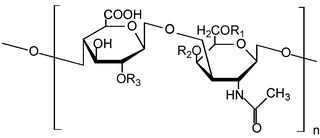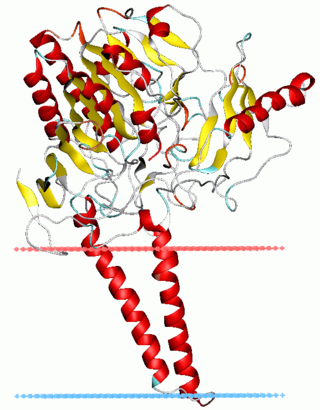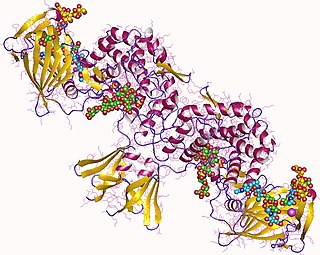
Glycosaminoglycans (GAGs) or mucopolysaccharides are long, linear polysaccharides consisting of repeating disaccharide units. The repeating two-sugar unit consists of a uronic sugar and an amino sugar, except in the case of the sulfated glycosaminoglycan keratan, where, in place of the uronic sugar there is a galactose unit. GAGs are found in vertebrates, invertebrates and bacteria. Because GAGs are highly polar molecules and attract water; the body uses them as lubricants or shock absorbers.

β-Glucuronidases are members of the glycosidase family of enzymes that catalyze breakdown of complex carbohydrates. Human β-glucuronidase is a type of glucuronidase that catalyzes hydrolysis of β-D-glucuronic acid residues from the non-reducing end of mucopolysaccharides such as heparan sulfate. Human β-glucuronidase is located in the lysosome. In the gut, brush border β-glucuronidase converts conjugated bilirubin to the unconjugated form for reabsorption. β-Glucuronidase is also present in breast milk, which contributes to neonatal jaundice. The protein is encoded by the GUSB gene in humans and by the uidA gene in bacteria.

Sulfatases EC 3.1.6.- are enzymes of the esterase class that catalyze the hydrolysis of sulfate esters. These may be found on a range of substrates, including steroids, carbohydrates and proteins. Sulfate esters may be formed from various alcohols and amines. In the latter case the resultant N-sulfates can also be termed sulfamates.
Sulfation is the chemical reaction that entails the addition of SO3 group. In principle, many sulfations would involve reactions of sulfur trioxide (SO3). In practice, most sulfations are effected less directly. Regardless of the mechanism, the installation of a sulfate-like group on a substrate leads to substantial changes.

Iduronate 2-sulfatase is a sulfatase enzyme associated with Hunter syndrome. It catalyses hydrolysis of the 2-sulfate groups of the L-iduronate 2-sulfate units of dermatan sulfate, heparan sulfate and heparin.

N-acetylgalactosamine-6-sulfatase is an enzyme that, in humans, is encoded by the GALNS gene.

N-acetylglucosamine-6-sulfatase (EC 3.1.6.14, glucosamine (N-acetyl)-6-sulfatase, systematic name N-acetyl-D-glucosamine-6-sulfate 6-sulfohydrolase) is an enzyme that in humans is encoded by the GNS gene. It is deficient in Sanfilippo Syndrome type IIId. It catalyses the hydrolysis of the 6-sulfate groups of the N-acetyl-D-glucosamine 6-sulfate units of heparan sulfate and keratan sulfate

Heparosan-N-sulfate-glucuronate 5-epimerase is an enzyme with systematic name poly( -beta-D-glucuronosyl- -N-sulfo-alpha-D-glucosaminyl) glucurono-5-epimerase. This enzyme catalyses the following chemical reaction
In enzymology, a phosphoadenylylsulfatase (EC 3.6.2.2) is an enzyme that catalyzes the chemical reaction
The enzyme chondro-4-sulfatase (EC 3.1.6.9) catalyzes the reaction
The enzyme disulfoglucosamine-6-sulfatase (EC 3.1.6.1) catalyzes the reaction
In enzymology, a glucuronate-2-sulfatase is an enzyme that catalyzes the chemical reaction of cleaving off the 2-sulfate groups of the 2-O-sulfo-D-glucuronate residues of chondroitin sulfate, heparin and heparitin sulfate.
The enzyme N-acetylgalactosamine-6-sulfatase catalyzes the chemical reaction of cleaving off the 6-sulfate groups of the N-acetyl-D-galactosamine 6-sulfate units of the macromolecule chondroitin sulfate and, similarly, of the D-galactose 6-sulfate units of the macromolecule keratan sulfate.
The enzyme N-sulfoglucosamine-3-sulfatase catalyzes cleaving off the 3-sulfate groups of the N-sulfo-D-glucosamine 3-O-sulfate units of heparin.

N-sulphoglucosamine sulphohydrolase is an enzyme that in humans is encoded by the SGSH gene.

Sulfatase 1, also known as SULF1, is an enzyme which in humans is encoded by the SULF1 gene.

Multiple sulfatase deficiency (MSD), also known as Austin disease, or mucosulfatidosis, is a very rare autosomal recessive lysosomal storage disease caused by a deficiency in multiple sulfatase enzymes, or in formylglycine-generating enzyme, which activates sulfatases. It is similar to mucopolysaccharidosis.

Formylglycine-generating enzyme (FGE), located at 3p26.1 in humans, is the name for an enzyme present in the endoplasmic reticulum that catalyzes the conversion of cysteine to formylglycine (fGly). There are two main classes of FGE, aerobic and anaerobic. FGE activates sulfatases, which are essential for the degradation of sulfate esters. The catalytic activity of sulfatases is dependent upon a formylglycine residue in the active site.
Heparanase is an enzyme with systematic name heparan sulfate N-sulfo-D-glucosamine endoglucanase. This enzyme catalyses the following chemical reaction

N-acetylglucosaminidase, alpha is a protein that in humans is encoded by the NAGLU gene.














